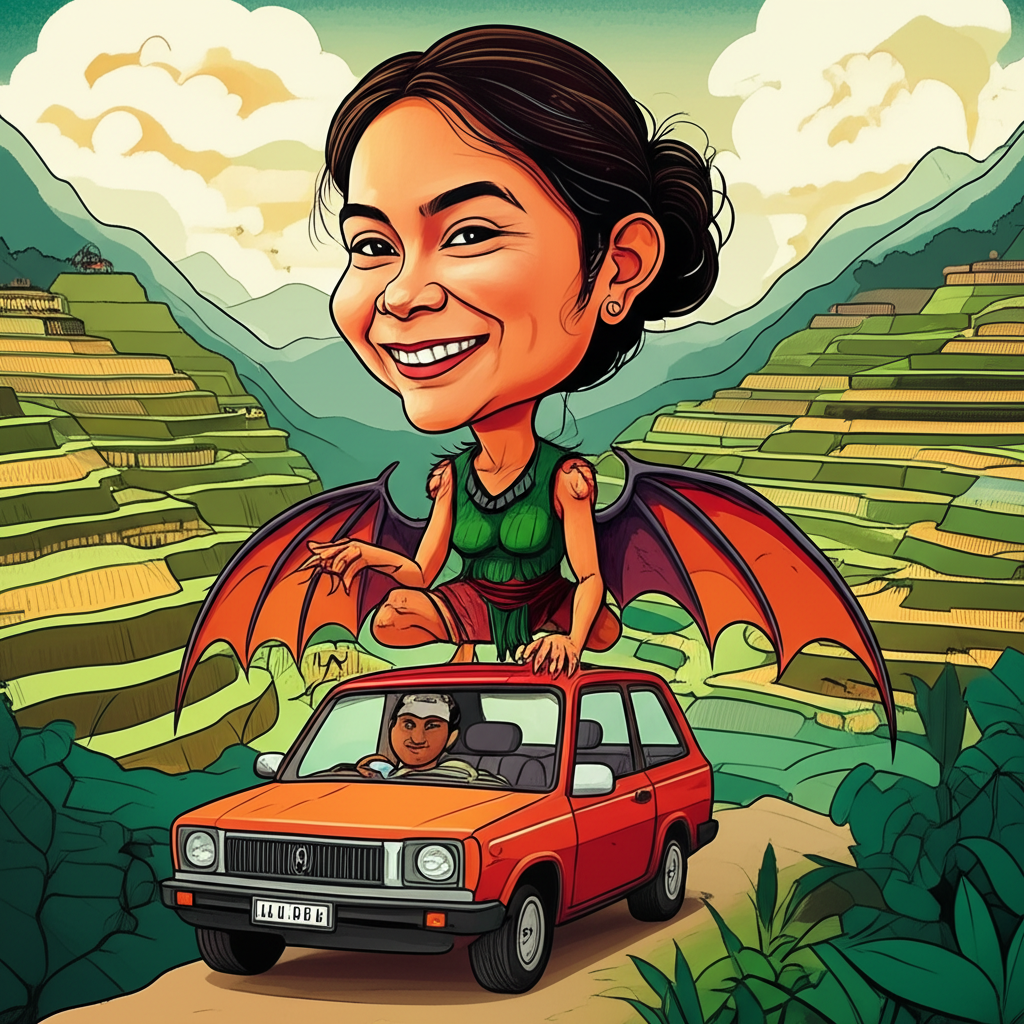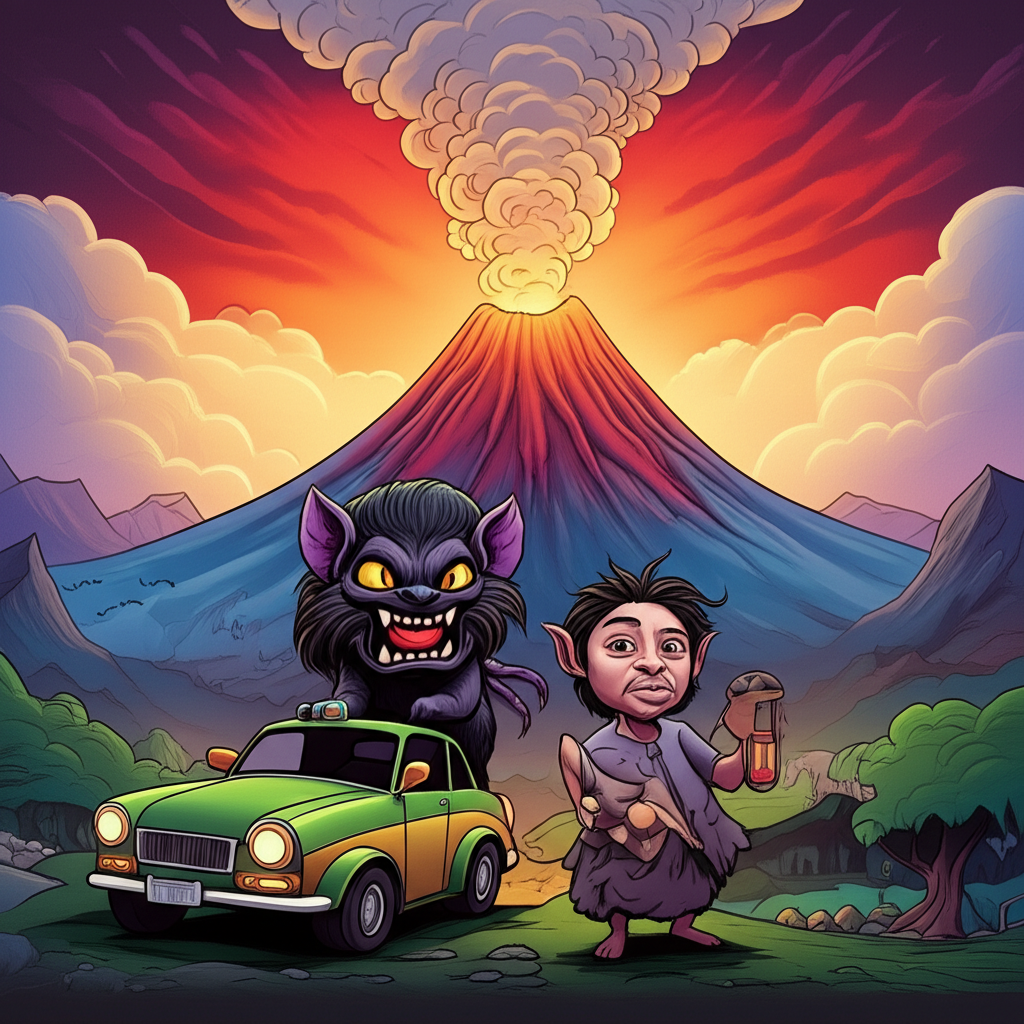
1. Introduction
In the verdant, storm-kissed lands of the Bicol region in the Philippines, a rich tapestry of folklore weaves through the very fabric of its people’s identity. Among these cherished narratives is a tale that intertwines the ancient spirit of the wind and lightning, Anitun Tabu, with the formidable yet enigmatic forest guardian, the Kapre, against the breathtaking backdrop of the Mayon Volcano. This story, like many others passed down through generations, is a traditional account crafted by the imaginative minds of ancient communities, designed to explain the mysteries of their world and impart timeless lessons. It is presented here purely for cultural, historical, and educational understanding, recognizing it as a fascinating product of human creativity and not as a factual account.
2. Origins and Cultural Background
The myth of Anitun Tabu, the Kapre, and Mayon Volcano emerged from a pre-colonial Filipino worldview, a time when the archipelago’s inhabitants lived in deep reverence for nature and its myriad forces. Their society was intimately connected to the land and sea, and their lives were dictated by the rhythms of the seasons, the bounty of the earth, and the unpredictable power of natural phenomena. In this animistic era, every mountain, river, tree, and creature was believed to possess a spirit or deity, influencing human affairs and the environment.
People of that time perceived the world as a vibrant, living entity, teeming with unseen beings—benevolent and malevolent, playful and fearsome. Deities like Anitun Tabu were understood to embody the raw power of nature, explaining the destructive fury of typhoons or the life-giving essence of rain. Spirits like the Kapre were seen as guardians of ancient places, their presence a reminder of the forest’s secrets and the need for respectful coexistence. Natural wonders, such as the Mayon Volcano, were not merely geological formations but often personified entities, their eruptions and serenity attributed to divine moods or tragic love stories. This holistic worldview fostered a profound respect for the environment, shaping their rituals, customs, and oral traditions.
3. Character / Creature Description
Central to this narrative are three distinct yet interconnected elements:
Anitun Tabu: In Bicolano mythology, Anitun Tabu is revered as the goddess of wind and lightning, a powerful and often temperamental deity. She embodies the dual nature of atmospheric forces: capable of bringing life-sustaining rains and gentle breezes, but also unleashing devastating storms and fiery lightning bolts. She is a symbol of nature’s unpredictable and awe-inspiring power, a force that demands respect and appeasement. Her attributes represent the raw, untamed energy of the skies, influencing everything from crop yields to the safety of sea voyages.
The Kapre: This mythical creature is a giant, tree-dwelling being, often described as dark-skinned, hairy, and immensely strong. Kapres are typically depicted perched high in ancient trees, particularly the sacred balete or century-old mango trees, often smoking a large, hand-rolled cigar whose glowing embers are visible from afar. Unlike purely malevolent spirits, Kapres are usually mischievous rather than evil. They might play tricks on travelers, disorienting them or making them lose their way, but rarely inflict serious harm unless provoked or disrespected. They are seen as guardians of the forest, ancient observers of the land, embodying the enduring mystery and hidden power of nature’s oldest sanctuaries.
Mayon Volcano: Known globally for its near-perfect cone shape, Mayon Volcano is the most active volcano in the Philippines and a majestic icon of the Bicol region. In local folklore, Mayon is intrinsically linked to the tragic love story of Daragang Magayon (Beautiful Maiden), whose burial place is said to be the volcano itself. For the purpose of this narrative, Mayon represents the earth’s sublime beauty and its inherent, terrifying power—a sleeping giant that can awaken with destructive force, mirroring the volatility of the divine.
4. Main Story / Narrative Retelling
In the age when the world was young and spirits walked freely among mortals, there stood a magnificent mountain in the Bicol lands, then known as ‘Bulkan Magayon’—the Beautiful Mountain, still in its nascent, tranquil form. Its slopes were covered in dense, ancient forests, and its peak often kissed the clouds in silent reverence.
Deep within these venerable woods, in the gnarled branches of a colossal balete tree, resided Ambo, an ancient Kapre. Ambo was a silent sentinel, his immense form blending seamlessly with the shadows of the forest. From his lofty perch, he observed the ebb and flow of life below: the gentle deer grazing, the vibrant birds nesting, and the distant villages where humans tilled the soil. His constant companion was the smoke of his enormous cigar, a fragrant haze that mingled with the forest mists. Ambo, with his millennia of watchful solitude, had come to understand the subtle language of the land and the sky. He felt the earth’s tremors before they were noticed by men and read the moods of the heavens in the shifting clouds.
One long season, a profound unease settled upon the land. The rains, usually abundant, became scarce, and the sun beat down with relentless ferocity. The crops withered, and the rivers dwindled to mere trickles. The people, in their desperation, grew restless, their pleas to the spirits seemingly unheard. A pervasive disrespect for the land began to spread, with trees felled recklessly and sacred groves defiled.
This imbalance did not escape the notice of Anitun Tabu, the fierce goddess of wind and lightning. Her domain was the sky, but her essence permeated the very air and earth. She observed the suffering of the land and the growing insolence of humankind. A profound anger began to simmer within her, a divine wrath born of cosmic justice.
Ambo, from his balete throne, felt the change in the air first. The usual gentle breezes turned sharp and cold, carrying an ominous hum. The sky, usually a canvas of soft blues and whites, frequently bruised with an unsettling purple, even when no storm was near. He saw the lightning flicker in the distant horizon, not as a cleansing rain, but as a warning. These were the echoes of Anitun Tabu’s growing fury.
Then came the day of reckoning. Anitun Tabu unleashed her full might. The heavens tore open, not with rain, but with a terrifying symphony of thunder and lightning. Bolts of pure energy, born from the goddess’s rage, struck the highest peaks, illuminating the darkened world in blinding flashes. Ambo, gripping his ancient tree, watched as the colossal lightning strikes, imbued with Anitun Tabu’s raw power, repeatedly lashed out at Bulkan Magayon. Each strike resonated deep within the earth, causing it to tremble violently.
The Beautiful Mountain, once a serene giant, began to groan. Cracks appeared on its slopes, spewing forth not water, but steam and ash. The ground beneath Ambo’s tree heaved and bucked. The air grew thick with sulfurous smoke, stinging his ancient eyes. He witnessed the very earth being reshaped by the goddess’s wrath, a testament to the colossal power of Anitun Tabu. The mountain roared, a sound unlike any beast, and from its heart, a river of molten rock began to flow, glowing an angry orange against the bruised sky. The perfect cone of Mayon, as it would come to be known, was not merely a creation of love, but a testament to the earth-shattering power of a goddess’s fury, her echoes reverberating through its fiery heart. Ambo, the Kapre, remained a silent witness, his ancient balete swaying, absorbing the shockwaves of creation and destruction, a solitary guardian observing the transformation of his world under the thunderous hand of Anitun Tabu.
5. Symbolism and Meaning
This narrative, woven from the threads of ancient beliefs, is rich in symbolism. Anitun Tabu represents the untamed power of nature—its capacity for both life-giving sustenance and devastating destruction. Her wrath, channeled through the earth-shaping event around Mayon, serves as a powerful reminder to ancient people of the importance of respecting the environment and maintaining harmony with the natural world. Disrespect, as depicted in the story, invites divine retribution.
The Kapre, Ambo, symbolizes the deep connection between the land and its ancient guardians. His wisdom, patience, and watchful presence represent the unseen forces that protect the natural order. He is a reminder that nature holds its own secrets and powers, often observed by entities beyond human perception. His role as a witness underscores the idea that humans are but one part of a larger, interconnected cosmos, and that there are mysteries and powers far greater than their own.
Mayon Volcano, in this context, embodies both sublime beauty and inherent danger. Its transformation or intense activity under Anitun Tabu’s influence serves as a powerful explanation for volcanic eruptions—not merely geological events, but expressions of divine emotion and consequence. It teaches that beauty can conceal immense power, and that the earth itself is a living entity capable of profound response. The story reinforces the Bicolano people’s reverence for Mayon, acknowledging its majestic beauty while also respecting its potential for destruction.
6. Modern Perspective
Today, the echoes of Anitun Tabu, the Kapre, and Mayon Volcano continue to resonate, albeit through a different lens. These myths are no longer literal explanations for natural phenomena but have evolved into cherished cultural touchstones. In modern Filipino literature, these characters and narratives are frequently reinterpreted, appearing in fantasy novels, poetry, and graphic novels that explore themes of identity, environmentalism, and the enduring power of folklore.
In popular media, Kapres, in particular, have become iconic figures in Filipino horror and fantasy films, television series, and video games, often depicted as formidable guardians or mischievous entities. Mayon Volcano, with its breathtaking beauty and dramatic history, remains a powerful symbol of national pride and a prime tourist destination, its legends enhancing its mystique. Academic cultural studies and anthropological research continue to explore these myths, analyzing their origins, their evolution, and their role in shaping cultural identity. These stories are vital for understanding the historical worldview of the Filipino people and for preserving a rich oral tradition that connects contemporary society to its ancient roots.
7. Conclusion
The narrative of Anitun Tabu, the Kapre, and Mayon Volcano is a testament to the profound imagination and cultural heritage of the ancient Filipino people. It is a story born from a time when humans sought to understand the world around them through personification and divine narratives, providing explanations for the inexplicable and instilling respect for the forces of nature.
It is crucial to re-emphasize that this is a cultural story, a product of human creativity, and not a belief system to be adopted. As Muslims, we recognize and affirm that only Allah (God) is the true Creator and Sustainer of the universe, the sole power behind all natural phenomena and the ultimate source of all wisdom. These traditional tales, while fascinating, are distinct from our faith.
In closing, the enduring appeal of such myths lies in their ability to connect generations, to spark imagination, and to remind us of the universal human quest for meaning and understanding. They are invaluable threads in the rich tapestry of global storytelling, offering unique insights into diverse cultural heritages and the shared human experience of living in a world full of wonder.





